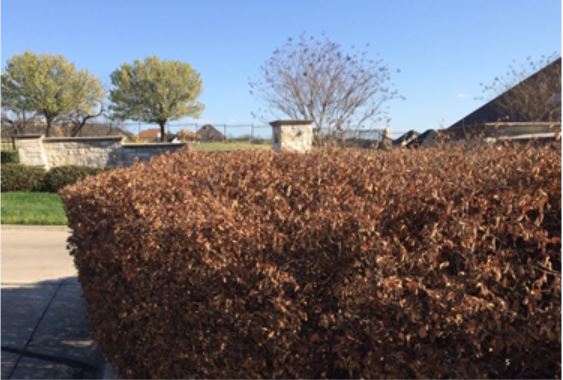
Architectural Guidelines Aren’t the Solution to These ACC Issues!
March 29, 2021Mother Nature left an uglyreminder of winter!Damage from freezing weatherin Februaryhas leftNorth Texaslandscapes looking brown and desiccated.However,now is not the time to start throwing out unsightly foliage, for the most part.
Ed Jensen, Vice President of OLM, a landscape consulting firm for HOA and commercial properties, explains what to do now to assess damage and how to care for freeze-damaged plants and trees.
“You may better assess whether a tree or shrub is going to make it after drought season or by July 4th.”
Assess and Wait
Trees have an uncanny ability to recover from storm damage. Before assuming your trees are lost, give them a quick assessment.
With shrubs, trees, and woody vines, you can look at twigs and start looking at the buds. Inspect branches to see if they’re green and still pliable or springy. Damaged leaves will shed naturally if the stems remain undamaged. Lightly scratching twigs or making a small cut on the lower branches on shrubs can reveal if the stem is still alive. If you see a vibrant green, that’s a good sign. If you see a drab green or brown color, the plant is probably on the decline.
If the tree was struggling or in decline before the freeze, it was more stressed and more likely to succumb frigid temperatures. Wait a few months before you fire up the chain saw. You may better assess whether a tree or shrub is going to make it after drought season or by July 4th. Ideally owners and associations can consult a tree professional such as an”¯ISA Certified Arborist to evaluate the tree and see if it can be saved.
Aesthetics and HOA Covenant Enforcement
Most HOA CC&Rs (Codes, Covenants and Restrictions) include some regulations regarding the duty of maintenance, that the owners and occupants must keep their landscapes well maintained and in attractive conditions at all times.
Given the extensive visible damage to plants, some leniency in enforcement is reasonable for the average homeowner’s property. For shrubs and groundcovers that don’t show signs of greening up, the prudent course may be not to replace it yet. An interim measure is to ask homeowners to cut them down and clean up debris.
For Live Oaks, it’s best for leaves to shed so new growth can form. However, leaf shedding may be gradual and depend upon weather conditions, such as wind and storms. Be sure that fallen leaves and debris are raked and removed to discourage decay and pests.
You can safely mow off ground cover to knock off brown leaves. Brown palm fronds are dead and can be removed safely. Otherwise, arborists recommend that you defer pruning trees until the next dormant season, especially for oaks, which are susceptible to oak wilt.
Dead or Alive?
Plants that are most likely dead from freeze damage include: Indian Hawthorne, Loropedalum, Oleander, Palms, and Pittosporum.
Plants that need some more time before considering removal include: Wax myrtle, Vitex, and Crape Myrtle, Giant Liriope, and Jasmine groundcover. In the next 30 days, you should see new buds and developing shoots on these plants. Wait to prune these plants until late summer, making minor pruning cuts to shape the plants and prune dead branches. Remember, these plants are trying to recover and need leaves to create energy and regain strength.
All other plants should recover. However, you can anticipate random branch die back which will need to be pruned as needed. The region is getting reasonable rainfall so only modest use of your irrigation systems is needed. If conditions get dry, you will need to water about 1 inch a week.

It is not uncommon for plants to fool us. You may be encouraged by new growth, but don’t be surprised that in the heat of a Texas summer random plants die for no apparent reason. Actually the reason may be freeze kill that didn’t manifest until late summer, when the plant just ran out of stored energy and could not sustain itself. This could happen more with trees such as Crape Myrtles or Oak trees.
While many reliable landscape picks suffered a set-back, one or two growing seasons may stimulate strong recovery. In the meantime, rain and proper irrigation will make a difference.
Be Prudent and Practical
Find some silver linings in the damaged vegetation. Take this opportunity to prune or replace overgrown shrubs that have been obscuring signs.
If planting beds must be completely reworked, consider converting to drip irrigation (save water and irrigation costs.)
When you replace damaged plants, opt for varieties that thrive in your zone. When you’re shopping for new plants, consider native species or adapted varieties, which will be more resilient during inclement weather.”¯

Ed Jensen
Vice President of OLM, Inc.
OLM, Inc. assiststheirclients in protecting the investment in both the landscape and interior facilities, while ensuring the visual qualities of the propertytohelp market its valuable assets.
About Certified Arborists
Certified Arborists“¯are individuals who have achieved a level of knowledge in the art and science of tree care through experience and by passing a comprehensive examination developed by some of the nation’s leading experts on tree care.
Other Resources:Texas A&M Forest Service; Cross Timbers Urban ForestryCouncil
If you found this article helpful, you may also find other topics relevant to your HOA on this blog: www.communitywellserved.com





